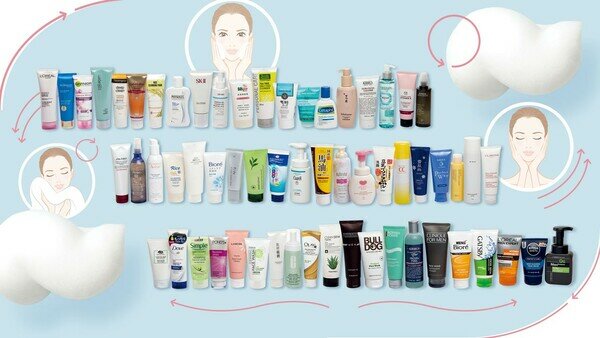Cleansing is the first step to skin care. Facial cleansers must therefore clean well but consumers should also be aware of the possible ingredients that may pose risks of allergy or other skin problems. In a test on 60 models of facial cleansers, the Consumer Council found various preservatives in 13 models, with allergy-causing CMIT/MIT or free formaldehyde present in 9 models and the MIT content in 1 model exceeding the latest European Union (EU) limit. Furthermore, over 30% of the cleansers were not listed with detailed ingredient information and 23 models without fully indicating the expiry date. Manufacturers are urged to enhance product labelling with higher transparency, so as to enable consumers to understand comprehensively the product ingredients and expiry before purchase.
Included in the 60 facial cleanser test models, prices of the samples varied sharply from some $20 to $410 – at per gram/per mL, their prices were calculated to differ from $0.15 to $3.42, a variation of over 21 times. The test focused on chemical and microbiological analyses as well as information on product labelling. The result showed that 70% (42 models) of the products, including the most pricy model ($410) and the lowest-priced ($20), both achieved the highest overall rating of 5 points, this reveals that there are quality products selling at affordable prices could be found in the market.
In chemical analysis, 5 models were detected with allergy-causing preservative MIT (methylisothiazolinone), with 2 of them containing both MIT and CMIT (methylchloroisothiazolinone) – in both cases these 5 models were within the limits of the Safety and Technical Standard for Cosmetics, 2015 version, China (0.01% and 0.0015%). However, one of the models for men, with 0.0083% of MIT, was found to have exceeded the latest EU Cosmetics Regulation limit (0.0015%) by 4.5 times. MIT/CMIT poses a higher risk of skin allergy, could cause reactions such as itchiness and rashes. Consumer suffering from eczema should avoid using products with these preservatives.
Another 4 models were detected with allergy-causing free formaldehyde, ranging in concentration from 0.001% to 0.043%, in compliance with the Mainland and EU limits of 0.2%. Nevertheless, people with wounds or prone to skin allergies are cautioned as even relatively small amount of free formaldehyde could potentially induce allergy.
In addition, 5 models were found with content of isopropyl alcohol. While there was not any set limit for isopropyl alcohol in both the Mainland and EU, prolonged skin contact with alcohol of high concentration, or frequent usage, may cause skin dryness. Besides, the test also found salicylic acid in 4 models, though they all fell within the limits of the Mainland and EU standards, if large amount of salicylic acid is absorbed through the skin, poisoning from salicylic acid may be resulted, showing discomforts like headache, vomiting and tinnitus.
Test result also revealed that, among the 60 test models, 27 were of an alkaline type (pH 8.9 - 10.9) while 33 were of a weak acidic to neutral type (pH 5.0 - 7.8). Some say using alkaline facial cleansers may affect pH balance of the skin, but according to a past research on 2 groups of people who used soap-based cleansers with high pH values and weak acidic cleansers for 5 years, has produced no difference in their skin recovery pH value before and after cleansing. Consumers with strong sebum secretion may choose to use facial cleaners with higher pH value, nevertheless, consumers should remarked these products may turn skin dry and tight, and are advised to apply moisturizer for skin care.
Improvement is clearly needed for 23 models to enhance product labelling, among which 19 models were found without listing out full ingredients in details. Most of these models were from Japan, including the model detected with MIT in excess of EU limit. Among the models with listing ingredients, some common fragrance allergens, colourants and other chemical substances were found. Samples without ingredient information are also likely to contain such ingredients. In the absence of sufficient information, consumers are at risk of choosing products unsuitable for them or even products with allergens.
All 23 models were found in need to enhance expiry date transparency, among these models, 14 showed only the usage period after opening, 1 showed only the production date, and 8 others were completely without any expiry date information. Although 37 models were marked with expiry dates, only 16 indicated the manufacturing date and expiry date / shelf life. In spite that consumers are generally aware of the need to rinse after application of facial cleansers, 5 models did not contain instructions for usage on the package of the products.
Manufacturers are urged to provide manufacturing dates, expiry dates and instructions on usage to enable consumers to obtain sufficient and accurate product information to avoid wastage.
Consumers are advised to heed the following:
- Read carefully the information on the products – the ingredients and the expiry dates; and avoid choosing facial cleansers containing allergy-causing ingredients and alcohol;
- People wearing make-up should first remove make-up and then thoroughly cleanse the skin with facial cleansers;
- Products with a higher pH value are generally better in removing grease but they may also render dry and tight skin;
- Apply moisturizers after cleansing, and put on sunscreen before heading out to protect the skin.
The Consumer Council reserves all its right (including copyright) in respect of CHOICE magazine and Online CHOICE.



